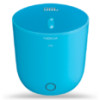Nokia MD-51W User Guide - Page 9
Product and safety information
 |
View all Nokia MD-51W manuals
Add to My Manuals
Save this manual to your list of manuals |
Page 9 highlights
9 If you have an issue, restore the original factory settings. If your issue remains unsolved, contact Nokia for repair options. Product and safety information Take care of your device Handle your device, battery, charger and accessories with care. The following suggestions help you protect your warranty coverage. • Keep the device dry. Precipitation, humidity, and all types of liquids or moisture can contain minerals that corrode electronic circuits. If your device gets wet, remove the battery, and allow the device to dry. • Do not attempt to open the device. • Unauthorized modifications may damage the device and violate regulations governing radio devices. • Do not drop, knock, or shake the device. • Only use a soft, clean, dry cloth to clean the surface of the device. • Switch off the device and remove the battery from time to time for optimum performance. Recycle Always return your used electronic products, batteries, and packaging materials to dedicated collection points. This way you help prevent uncontrolled garbage disposal and promote the recycling of materials. Batteries and chargers Battery and charger info Your device is intended for use with a BL-5J rechargeable battery. Nokia may make additional battery models available for this device. Always use original Nokia batteries. This device is intended for use when supplied with power from the following chargers: AC-50 . The exact Nokia charger model number may vary depending on the plug type, identified by E, X, AR, U, A, C, K, B, or N. Battery safety Always switch the device off and unplug the charger before removing the battery. When you unplug a charger or an accessory, hold and pull the plug, not the cord. When your charger is not in use, unplug it from the electrical plug and the device. Do not leave a fully charged battery connected to a charger, as overcharging may shorten the battery's lifetime. If left unused, a fully charged battery will lose its charge over time. Always keep the battery between 15°C and 25°C (59°F and 77°F). Extreme temperatures reduce the capacity and lifetime of the battery. A device with a hot or cold battery may not work temporarily. Accidental short-circuiting can happen when a metallic object touches the metal strips on the battery, for example, if you carry a spare battery in your pocket. Short-circuiting may damage the battery or the connecting object. Do not dispose of batteries in a fire as they may explode. Dispose of batteries according to local regulations. Recycle when possible. Do not dispose as household garbage. Do not dismantle, cut, open, crush, bend, puncture, or shred cells or batteries. If a battery leaks, do not let battery liquid touch skin or eyes. If this happens, immediately flush the affected areas with water, or seek medical help. Do not modify, remanufacture, attempt to insert foreign objects into the battery, or immerse or expose it to water or other liquids. Batteries may explode if damaged.












